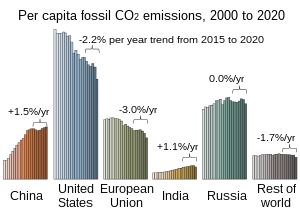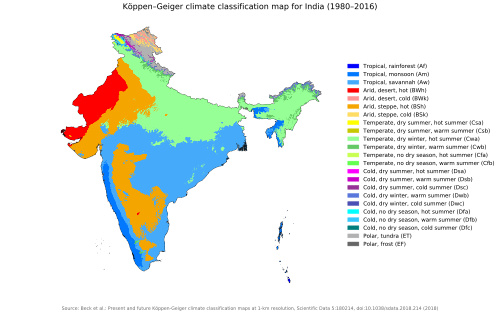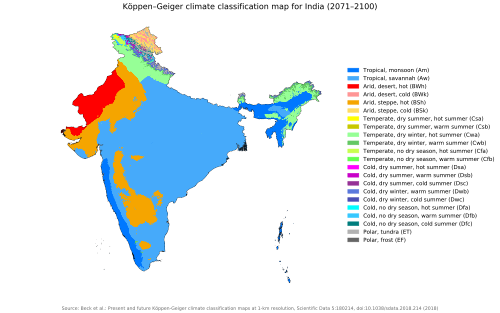Climate change in India is having profound effects on India, which is ranked fourth among the list of countries most affected by climate change in the period from 1996 to 2015. India emits about 3 gigatonnes (Gt) CO2eq of greenhouse gases each year; about two and a half tons per person, which is half the world average. The country emits 7% of global emissions. Temperature rises on the Tibetan Plateau are causing Himalayan glaciers to retreat, threatening the flow rate of the Ganges, Brahmaputra, Yamuna, and other major rivers; the livelihoods of hundreds of thousands of farmers depend on these rivers. A 2007 World Wide Fund for Nature (WWF) report states that the Indus River may run dry for the same reason. Heat waves’ frequency and power are increasing in India because of climate change. Severe landslides and floods are projected to become increasingly common in such states as Assam.
The Indira Gandhi Institute of Development Research has reported that, if the predictions relating to global warming made by the Intergovernmental Panel on Climate Change come to fruition, climate-related factors could cause India’s GDP to decline by up to 9%. Contributing to this there would be shifting growing seasons for major crops such as rice, production of which could fall by 40%.
Greenhouse gas emissions

CO
2 emissions in India are much less than China but rising much more quickly.

India generates much less carbon dioxide per person than other primary regions.
Greenhouse gas emissions by India are the third largest in the world and the main source is coal. India emits about 3 gigatonnes (Gt) CO2eq of greenhouse gases each year; about two and a half tons per person, which is half the world average. The country emits 7% of global emissions.
As of 2019 these figures are quite uncertain, but a comprehensive greenhouse gas inventory is within reach. Cutting greenhouse gas emissions, and therefore air pollution in India, would have health benefits worth 4 to 5 times the cost, which would be the most cost-effective in the world.
As of 2014, India’s carbon intensity per GDP was twice the world average. The Paris Agreement commitments included a reduction of this intensity by 33-35% by 2030. India emitted 2,600 Mt of CO2eq in 2014 (2,300 Mt with LULUCF). The UNEP forecasts that by 2030 India’s annual emissions per person will be between 3 and 4 tonnes.
According to data from 2009 India is the world’s third biggest emitter of CO2 after China and the United States – pushing Russia into fourth place.
Energy
Energy in India is the main source. As of 2019 fossil fuels were subsidized more than clean energy.
Electricity generation
As of 2019 three-quarters of electricity is generated by burning fossil fuels. Energy emissions increased by 1,563 megatons CO2eq from 1990 to 2014. Over 74% of energy was generated by coal in 2014.
Coal fired power stations
As well as coal mining in India, the country also imports coal to burn in coal-fired power stations in India. New plants are unlikely to be built, old and dirty plants may be shut down and more coal may be burnt in the remaining plants.
Transport fuel
90% of transport emissions are from road transport.
Household fuel
Switching from traditional fuels to liquefied petroleum gas and electricity provides health and climate benefits.
Industry
A quarter of emissions are industrial mainly from producing cement, iron and steel. Industrial sector fuel consumption increased by 406% between 2000 and 2014.
As of 2014, 42% of energy was also consumed by industry.
Agriculture
Agricultural emissions increased 25% between 2005 and 2014, in part due to significant increases in the use of artificial fertilizers.
Waste
Waste emitted 78 Mt of CO2eq in 2014.
Impacts on the natural environment
Temperature and weather changes
Temperatures in India have risen by 0.7 °C (1.3 °F) between 1901 and 2018, thereby changing the climate in India.
A 2018 study projects droughts to increase in Northern and North-western India in the near future. Around the end of the century, most parts of India will likely face more and more severe droughts.
Severe landslides and floods are projected to become increasingly common in such states as Assam.


Sea level rise

The tiny low-lying islands of Lakshadweep may be inundated by sea level rises associated with climate change.
Meghalaya and other northeastern states are concerned that rising sea levels will submerge much of Bangladesh and spawn a refugee crisis. If severe climate changes occurs, Bangladesh and parts of India that border it may lose vast tracts of coastal land.:130
Thousands of people have been displaced by ongoing sea level rises that have submerged low-lying islands in the Sundarbans.
Water resources
Temperature rises on the Tibetan Plateau are causing Himalayan glaciers to retreat, threatening the flow rate of the Ganges, Brahmaputra, Yamuna, and other major rivers; the livelihoods of hundreds of thousands of farmers depend on these rivers. A 2007 World Wide Fund for Nature (WWF) report states that the Indus River may run dry for the same reason.
Ecosystems
Ecological disasters, such as a 1998 coral bleaching event that killed off more than 70% of corals in the reef ecosystems off Lakshadweep and the Andamans and was brought on by elevated ocean temperatures tied to global warming, are also projected to become increasingly common.
Impacts on people
Economic impacts
India has the world’s highest social cost of carbon. The Indira Gandhi Institute of Development Research has reported that, if the predictions relating to global warming made by the Intergovernmental Panel on Climate Change come to fruition, climate-related factors could cause India’s GDP to decline by up to 9%; contributing to this would be shifting growing seasons for major crops such as rice, production of which could fall by 40%.
Agriculture
Climate Change in India will have a disproportionate impact on the more than 400 million that make up India’s poor. This is because so many depend on natural resources for their food, shelter and income. More than 56% of people in India work in agriculture, while many others earn their living in coastal areas.
Health impacts
Air pollution, which reflects sunlight, and irrigation, which cools the air by evaporation, have counteracted climate change since 1970. These two factors do however increase the impact of heat waves, as both lead to increased mortality.
Heat waves
Heat waves’ frequency and power are increasing in India because of climate change. In 2019, the temperature reached 50.6 degrees Celsius, 36 people were killed. The high temperatures are expected to impact 23 states in 2019, up from nine in 2015 and 19 in 2018. The number of heat wave days has increased — not just day temperature, night temperatures increased also. 2018 was the country’s sixth hottest year on record, and 11 of its 15 warmest years have occurred since 2004. The capital New Delhi broke its all-time record with a high of 48 degrees Celsius.
In India, exposure to heat waves is said to increase by 8 times between 2021 and 2050, and by 300% by the end of this century. The number of Indians exposed to heat waves increased by 200% from 2010 to 2016. Heat waves also affect farm labour productivity. The heat waves affect central and northwestern India the most, and the eastern coast and Telangana have also been affected. In 2015, the latter places witnessed at least 2500 deaths. In 2016, for the first time in history, Kerala reported a heat wave. The government is being advised by the Indian Institute of Tropical Meteorology in predicting and mitigating heat waves. The government of Andhra Pradesh, for instance, is creating a Heat Wave Action Plan.
The death toll from India’s heat waves has decreased in the last four years. More than 2,000 people died in 2015, 375 in 2017 and 20 in 2018. “Officials say this is because the government has made an effort to reduce the death toll by encouraging residents to reduce or alter the time spent working on hot days and by providing free drinking water to hard-hit populations”. It also used water to cool streets and forced police to guard water tankers in Madhya Pradesh state after fights over supply turned deadly. Those measures cost a lot of money and water, and the government’s resources were limited in 2019 by the country’s national election. The heat wave may continue, as monsoon rains have been delayed this year.
Impacts on migration
Around seven million people are projected to be displaced due to, among other factors, submersion of parts of Mumbai and Chennai, if global temperatures were to rise by a mere 2 °C (3.6 °F).
Villagers in India’s North Eastern state of Meghalaya are also concerned that rising sea levels will submerge neighboring low-lying Bangladesh, resulting in an influx of refugees into Meghalaya which has few resources to handle such a situation.
Mitigation

India is ranked high in Climate change performance Index
Greenhouse gas sinks
Land use, land-use change, and forestry absorbed 300 Mt of CO2eq in 2014 and in 2020 total carbon stored in forests was 7000 Mt.
Energy policy
The National Energy Plan is in accord with the Paris Agreement target of 2 °C global warming, but if India stopped building coal-fired power stations it would meet the 1.5 °C aspiration. India pledged to achieve electric power generation of 40% percent non-fossil fuel energy by 2030.
India’s Intended Nationally Determined Contribution includes reducing emission intensity by a third by 2030.
India’s economy is forecast to grow significantly, with gross domestic product rising 7-8% annually. The government expects electricity capacity needs to nearly double to 2027. With accelerated coal plant closures, and an anticipated surge in renewables, thermal power will account for only an estimated 42.7% of installed capacity across India by 2027, down dramatically from 66.8% in 2017.
Cutting greenhouse gas emissions, and therefore air pollution in India, would have health benefits worth 4 to 5 times the cost, which would be the most cost-effective in the world.
India has made significant strides in the energy sector and the country is now a global leader in renewable energy. In 2011 India achieved a record $10.3 billion (USD) in clean energy investments, which the country is now using to fund solar, wind, and hydropower projects around the country.
Policies and legislation
The Indian Central Government as well as various state governments have taken certain steps in accordance with India’s energy policy and the Paris Agreement. Following are some of those steps:
- Doubling India’s renewable energy target to 450 gigawatt (GW) by 2030
- National Solar Mission
- Wind power in India
In 2008, India published its National Action Plan on Climate Change (NAPCC), which contains several goals for the country. These goals include but are not limited to: covering one third of the country with forests and trees, increasing renewable energy supply to 6% of total energy mix by 2022, and the further maintenance of disaster management. All of the actions work to improve the resiliency of the country as a whole, and this proves to be important because India has an economy closely tied to its natural resource base and climate-sensitive sectors such as agriculture, water, and forestry.
International cooperation
As a party to the Paris Agreement India is due to submit its first Biennial Transparency Report (BTR) to the UNFCCC by 2024 and inventory figures in standard format.
Adaptation
An Ice Stupa designed by Sonam Wangchuk brings glacial water to farmers in the Himalayan Desert of Ladakh, India.
A research project conducted between 2014 and 2018 in the five districts (Puri, Khordha, Jagatsinghpur, Kendrapara and Bhadrak) of Mahanadi Delta, Odisha and two districts (North and South 24 Parganas) of Indian Bengal Delta (includes the Indian Sundarbans), West Bengal provides evidence on the kinds of adaptations practiced by the delta dwellers. In the Mahanadi delta, the top three practiced adaptations were changing the amount of fertiliser used in the farm, the use of loans, and planting of trees around the homes. In the Indian Bengal Delta, the top three adaptations were changing the amount of fertiliser used in the farm, making changes to irrigation practices, and use of loans. Migration as an adaptation option is practiced in both these deltas but is not considered as a successful adaptation.
In the Indian Sundarbans of West Bengal, farmers are cultivating salt-tolerant rice varieties which have been revived to combat the increasing issue of soil salinity. Other agricultural adaptations include mixed farming, diversifying crops, rain water harvesting, drip irrigation, use of neem-based pesticide, and ridge and farrow land shaping techniques where “the furrows help with drainage and the less-saline ridges can be used to grow vegetables.” These have helped farmers to grow a second crop of vegetables besides the monsoon paddy crop.
In Puri district of Odisha, water logging is a hazard that affects people yearly. In the Totashi village, many women are turning the “water logging in their fields to their advantage” by cultivating vegetables in the waterlogged fields and boosting their family income and nutrition.
Society and culture
Awareness
A qualitative analysis of some mainstream Indian newspapers (particularly opinion and editorial pieces) during the release of the IPCC 4th Assessment Report and during the Nobel Peace Prize win by Al Gore and the IPCC found that Indian media strongly pursue the frame of scientific certainty in their coverage of climate change. This is in contrast to the skepticism displayed by American newspapers at the time. Alongside, Indian media highlight frames of energy challenge, social progress, public accountability and looming disaster. This sort of coverage finds parallels in European media narratives as well and helps build a transnational, globalized discourse on climate change. Another study has found that the media in India are divided along the lines of a north–south, risk-responsibility discourse. However, much more research is required to analyse Indian media’s role in shaping public perceptions on climate change.
Activism
Calculations in 2021 showed that, for giving the world a 50% chance of avoiding a temperature rise of 2 degrees or more India should increase its climate commitments by 55%.:Table 1 For a 95% chance it should increase the commitments by 147%. For giving a 50% chance of staying below 1.5 degrees India should increase its commitments by 191%.
There have been school strikes for climate organised by activists such as Disha Ravi.
Tribal people in India’s remote northeast planned to honor former U.S. Vice President Al Gore in 2007 with an award for promoting awareness on climate change that they say will have a devastating impact on their homeland.
Meghalaya- meaning ‘Abode of the Clouds’ in Hindi—is home to the towns of Cherrapunji and Mawsynram, which are credited with being the wettest places in the world due to their high rainfall. But scientists state that global climate change is causing these areas to experience an increasingly sparse and erratic rainfall pattern and a lengthened dry season, affecting the livelihoods of thousands of villagers who cultivate paddy and maize. Some areas are also facing water shortages.
People are becoming aware of ills of global warming. Taking initiative on their own people from Sangamner, Maharashtra (near Shirdi) have started a campaign of planting trees known as Dandakaranya- The Green Movement. It was started by visionary & ace freedom fighter the late Shri Bhausaheb Thorat in the year 2005. To date, they have sowed more than 12 million seeds & planted half a million plants.
Women
To understand gendered vulnerabilities one needs to understand it in conjunction with caste, class, and ethnicity. In India’s Mahanadi Delta, women from Scheduled Castes exhibited high levels of self-confidence and self-esteem in spite of facing deprivation. While women from higher castes are bound by “stronger patriarchal control and restricted mobility”, women from Scheduled Castes “often without even realizing it” are capable of doing away with patriarchal limitations and “acquire mobility with greater ease”.
The perception of women as being “only vulnerable and marginalized in the context of climate change” is incorrect. Women’s agency to cultivate vegetables in water logged fields of Totashi village of Odisha has turned the disadvantages caused by water logging on its head by providing them with additional income to support their families and nutritional requirement. Women of Odisha’s Jeypore village volunteer twice a month to clear out water hyacinth from the water bodies by forming a chain to “pull floating sections of water hyacinth prior to uprooting them”. This has not only improved the water quality of the ponds and enabled villagers to engage in duck farming and fishing but also checked the reduction of soil fertility and spread of diseases, snakes, and poisonous insects.
A study conducted between 2014 and 2018 in five districts of the Mahanadi delta of Odisha show that female-headed households experienced “more monetary losses due to failure of crop, livestock and equipment damages as well as loss of life” as compared to the male headed households during extreme events. The female headed households had the existing responsibilities of looking after the family, and coupled with lower incomes, lower resilience or adaptive capacity, they were worse off than male headed households during extreme events. The inequalities were further compounded by the women’s age, marital status, lack of education, and income where a proportion of women had no income, many had low income, and a significant proportion were widows of mature age with no education. Not only were these women living under vulnerable physical conditions in the delta owing to a changing climate but were also socio-economically more vulnerable than the male-headed households.
